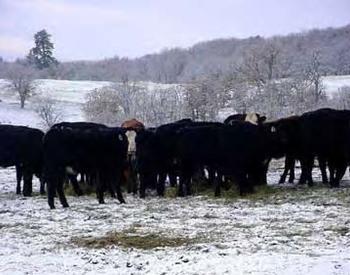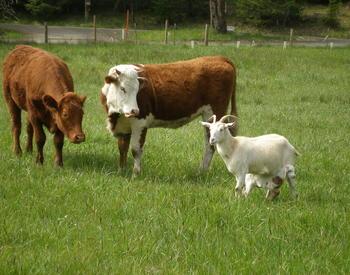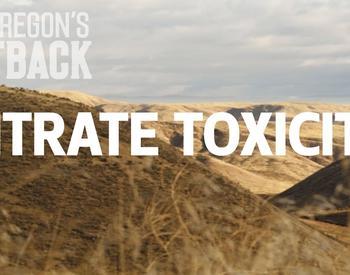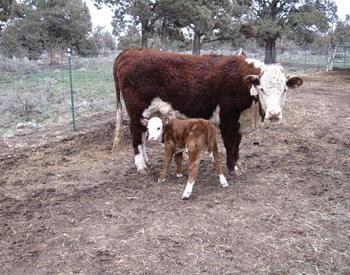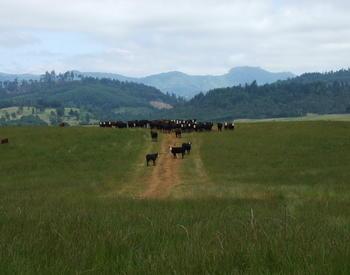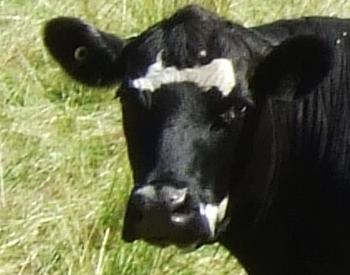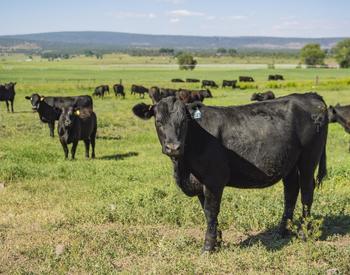Introduction
The major objective of cow-calf operations is to produce one calf per cow every year. Therefore, adequate reproduction of the herd is imperative for efficiency and profitability of cow-calf systems.
Basically, herd reproductive performance is determined by fertility of cows and bulls and the capacity of bulls in identifying and servicing cows in heat. If one of these factors is inadequate, reproductive rates will be significantly impaired.
Therefore, beef cows and bulls need to be properly managed to ensure adequate cow-calf production efficiency. Although a lot of attention is directed toward reproductive management of females (see other publications within the OSU – Beef Cattle Library and the Cow-Calf Management Guide and Cattle Producer’s Library), bull reproductive management is often overlooked. Infertility of a single cow results in one less calf, whereas infertility of one bull results in several fewer calves by impacting reproductive performance of all the cows that the bull was expected to breed.
The first step for proper bull management is to understand anatomy and physiology concepts of the bull’s reproductive system. With this basic knowledge, producers and field personnel will be able to better comprehend and employ the tools available for enhanced bull reproduction.
Anatomy
The major structures of the bull reproductive tract are the penis, testicles, and the accessory organs and glands responsible for sperm maturation and transport, including epididymis, seminal vesicles and prostate (Figure 1). Some of their features and functions are:
Testicles
Bulls have a pair of testicles that have two main functions: production of sperm cells (spermatozoa) and synthesis of testosterone, the male hormone. The testicles are located outside the body cavity of bulls and housed in the scrotum; a sac of skin containing sweat glands, muscles and tissues to protect the testicles from impact and extreme temperatures.
Sperm cells are constantly synthesized within the testicles by the seminiferous tubes, a collection of hundreds of winding tubules surrounded by testosterone-producing cells, which fuse into a few dozen larger tubules and culminate in the epididymis.
Epididymis
Attached to the testicle, the epididymis is divided into three regions: the head, body and tail. The head and body of the epididymis are responsible for receiving the sperm cells from the testicles. Sperm cells stay in these regions for a few days, while they mature to become fertile and move toward the tail of the epididymis. In the tail of the epididymis, fertile sperm cells are stored up to eight days until they are either reabsorbed or shipped out of the epididymis if ejaculation occurs.
Ductus deferens
Also known as vas deferens, these tubes are responsible for transporting the sperm cells from the tail of the epididymis into the penis during ejaculation. During transportation, sperm cells are mixed with fluids, known as seminal plasma, produced by accessory sex glands (seminal vesicles, prostate and Cowper’s glands) attached to the ductus deferens with the purpose of diluting and enhancing fertility of sperm cells.
Penis
The organ responsible for copulation and deposition of semen into the cow’s reproductive tract. The penis is maintained inside the body of the bull by the sigmoid flexure, an anatomical structure that prevents exposure of the penis to prevent injuries. During copulation, the musculature responsible for the sigmoid flexure (retractor muscles) relaxes and the penis extends and becomes exposed.
Physiology of bull reproduction
To better understand the reproductive system of bulls, we first need to recognize the main hormones produced by the bull’s body to control reproduction. These are:
- FSH (follicle stimulating hormone) — Responsible for stimulating synthesis of sperm cells in the testicle.
- LH (luteinizing hormone) — Responsible for stimulating testosterone production in the testicles.
- GnRH (gonadotropin releasing hormone) — Synthesized by the hypothalamus in the brain, its main function is to stimulate synthesis of LH and FSH by the pituitary gland, which is also located within the brain.
- Testosterone — Responsible for sexual development and sex characteristics in males, required for synthesis of sperm cells and bull libido (sexual drive).
Fertile sperm cells are constantly being produced in sexually mature bulls in a process known as spermatogenesis. In bulls, this process may take up to 60 days. Therefore, the sperm cells that the bull will use to service cows are beginning to be produced two months before breeding.
This is particularly important because any changes in bull management, either beneficial (i.e., nutritional programs) or deleterious (i.e., stress and disease), will affect the quality of the ejaculate weeks later. When the sperm cells reach the ductus deferens and are mixed with fluids from the accessory glands, the semen is formed. On average, a beef bull produces 6 billion sperm cells daily and is capable of ejaculating 3 to 5 cc of semen containing 1 billion sperm cells per cc of semen.
The capacity of a beef bull to produce sperm cells is mainly associated with the size of its testicles. Bigger testicles are capable of producing more sperm cells compared with smaller testicles. A normal sperm cell is illustrated in Figure 2. The genetic material of the sperm cell is located in the head, whereas the tail is responsible for locomotion of the sperm cell. To be fertile, the sperm cell has to be morphologically complete, which means viable genetic material and ability to move in the cow’s reproductive tract.
In order to be sexually competent, bulls need to achieve puberty. Before puberty, bulls are not capable of producing fertile sperm cells and consequently are unable to fertilize females. Puberty in males is achieved when a significant amount of fertile sperm cells is present in the ejaculate. The puberty process is initiated when the GnRH and consequent LH and FSH synthesis by the brain reaches a threshold that initiates production of testosterone and fertile sperm cells by the testicles.
On average, beef bulls reach puberty at 12 months of age, but this number varies based on genetics, nutrition, environment, health and other factors that the bull is exposed to. As an example, under adequate nutritional and management scenarios, Holstein bulls can reach puberty as early as 8 months of age, whereas Brahman bulls typically reach puberty after 15 months of age.
Breeding soundness and libido exams
Before bulls are assigned to breeding, it is important to determine if the bull is fertile and capable of servicing females. A breeding soundness exam addresses the first question by evaluating fertility parameters of the bull. The libido and serving capacity exam determines the ability of the bull to complete the act of breeding.
It is important to note that many bulls that are approved by the breeding soundness exam can still be unproductive if they lack in libido and serving capacity. In addition, bulls can unexpectedly become reproductively inept due to several reasons, including age, disease, injury and malnutrition; therefore, bulls should undergo breeding soundness and libido exams every year prior to breeding.
Breeding soundness exam
A breeding soundness exam should be performed by trained personnel and consists of:
- Physical examination — The bull needs to be able to see, eat, smell and move properly to be physically able to breed cows. Therefore, eyes, mouth, feet, legs and nutritional status of bulls should be evaluated and be in proper condition prior to breeding.
- Reproductive organs — The scrotum, testicles, epididymes and penis should be physically evaluated for evidence of disorders. The internal accessory glands should be evaluated via rectal palpation to check for inflammation and other concerns.
- Semen evaluation — Semen can be collected with the use of an electro-ejaculator or with the use of a mannequin. Samples are evaluated for sperm concentration (number of sperm cells per cc of ejaculate), motility (ability of sperm cells to move) and morphology (incidence of misshapen sperm cells). The circumference of the testicle should also be measured to ensure that only bulls with adequate capacity for sperm production are being used.
Based on these evaluations, bulls are classified as satisfactory or unsatisfactory potential breeder based on the system developed by the Society for Theriogenology. Specific information about breeding soundness exam is available online. Bulls that fail this exam can be retested again three to four weeks later. This is particularly important when young bulls are being evaluated, as they may be reaching puberty during the testing period.
It is important to note that bulls approved by the breeding soundness exam are classified as satisfactory potential breeder, which means that the breeding soundness exam does not guarantee that the bull will certainly sire calves.
Libido and serving capacity exam
To evaluate the potential of the bull in servicing cows, bulls approved by the breeding soundness exam should also be assigned to a libido and serving capacity exam. A common method to evaluate bulls for these traits briefly consists of:
- Restrain two females 25 feet apart in a small pen. Females do not have to be in heat but should be mildly sedated to prevent injuries.
- Stimulate bulls before test by watching other bulls mount the restrained females for 10 minutes.
- Include two or three testing bulls into the pen with females and record their sexual activity for 10 minutes.
- Apply the scoring system from Table 1.
| Score | Description |
|---|---|
| 0 | The bull shows no sexual interest |
| 1 | Sexual interest shown only once (i.e., sniffing) |
| 2 | Sexual interest more than once |
| 3 | Active sexual interest throughout the test |
| 4 | Once mount or mounting attempt with no service |
| 5 | Two mounts or mounting attempts with no service |
| 6 | More than two mounts or mounting attempts with no service |
| 7 | One service followed by no further sexual interest |
| 8 | One service followed by sexual interest, including mounts or mounting attempts |
| 9 | Two services followed by no further sexual interest |
| 10 | Two services followed by sexual interest, including mounts or attempts, or further services |
The bulls should be tested at least twice, preferable on different days. High-serving capacity bulls are those that score above six. Bulls that score 10 very quickly can be removed from the pen before the completion of the test. If some bulls seem intimidated by other bulls and/or observers, the bull can be left in with females for 20 minutes. Always test bulls of similar ages in the same groups.
There are major concerns associated with animal and personnel welfare when performing libido and servicing capacity exams. However, there are no alternative options to properly evaluate breeding bulls for these characteristics. Therefore, adequate facilities, environment and trained/experienced personnel are imperative when performing these tests. Remember, libido and serving capacity testing should be combined with the breeding soundness exam to determine if the bull is fertile and capable of servicing cows.
Conclusion
Bull fertility and serving ability will determine the reproductive performance of the cows that the bull is expected to breed. Consequently, reproductive ability of bulls should be evaluated annually prior to breeding. Understanding the anatomy and function of the organs that control reproduction in bulls will provide essential information to producers and field personnel to properly manage these animals, as well as identify the importance and comprehend the outcomes of breeding soundness and serving capacity exams.
References
Cooke, R. F., and R. Torell. In: Cow-Calf Management Guide, CL435.
Duren, E., and J. Walker. In: Cow-Calf Management Guide, CL425.
Hansen, G. R. 2006. University of Florida — IFAS Extension.
Senger, P. L. 2003. Pathways to Pregnancy and Parturition. 2nd edition. Current Conceptions Inc. Pullman, WA, USA.
Turman, E. J., and T. D. Rich. In: Cow-Calf Management Guide, CL424.
This document is part of the Oregon State University — Beef Cattle Library (BEEF057). Prior to acceptance, this document was anonymously reviewed by two experts in the area.




